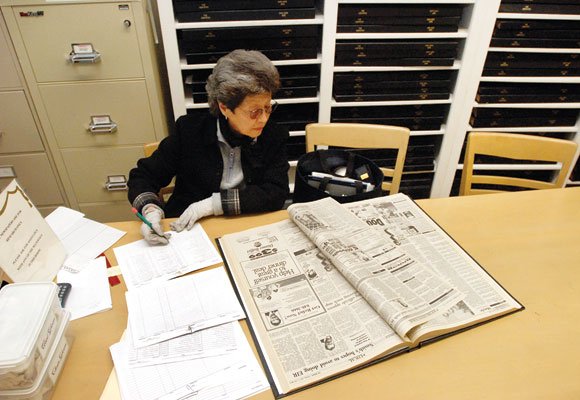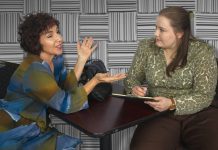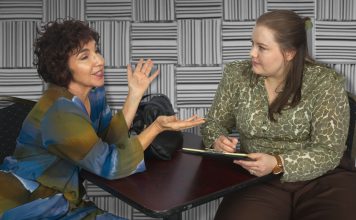Hundreds of time travelers visited Gilroy last year from 24
different U.S. states. They journeyed over land and sea from eight
foreign countries. They came to fill a void in their personal
story, to learn about another place and time, to settle an estate
or to link up with family they didn’t even know they had.
Hundreds of time travelers visited Gilroy last year from 24 different U.S. states. They journeyed over land and sea from eight foreign countries. They came to fill a void in their personal story, to learn about another place and time, to settle an estate or to link up with family they didn’t even know they had.
“You are the face of Gilroy,” Recreation Coordinator Susan Voss said to volunteers filling the rotunda of the Gilroy Museum Saturday. “We had 1,700 visitors this past year. Often the museum is the only governmental institution people will visit while here.”
The volunteers attended an intensive 2.5-hour training session to learn how to staff the museum. As city budget cuts have forced layoffs of the museum’s dedicated staff members Tom Howard and Susan Voss, volunteers are now the only thing keeping the museum open.
“So what is a museum?” Voss asked the group of more than 20 volunteers, which included Planning Division Manager Bill Faus, retired teacher Phill Laursen, former Mayor Roberta Hughan, and Gilroy historian Katherine Tsujimoto.
“It’s the life of Gilroy,” volunteer Betty Jane Kelly, an employee of the Gilroy Telephone Company for 40 years, answered as the group practiced guiding a tour of the museum.
After city staff are laid off Saturday, volunteers have arranged with the city to keep the museum open Tuesdays and Thursdays from 9 a.m. to 5 p.m., primarily to educate more than 400 school children each year, and the first Saturday of the month from 10 a.m. to 2 p.m., chiefly to help visitors.
I visited a similar city museum in my quest to find my great-great-grandfather, Ransom Powell. The only information I had was a family rumor that he had been buried in a place called Healdsburg, a small city north of San Francisco. The museum told me my ancestor had come west in a wagon train from Missouri during the 1849 Gold Rush. His wife, Elizabeth, died on the way and was buried roadside in Colorado. Yet, fortunately for me, her baby (my great-grandfather) survived in the care of another woman in the wagon train. Ransom married her and soon became a successful selling goods to miners.
The museum directed me to the cemetery where Ransom was buried with three of his five wives (the fifth one outlived him and is buried with her family). They located the Italianate Victorian house he built in 1869. There, I found the owners occasionally dressed up to play him and his wife during Healdsburg’s living history days. The museum provided me with so many vivid stories and newspaper photos that when I stepped into his home, I felt like I could almost see him peering out at me from around each corner.
Gilroy is taking inspiration from Healdsburg, which was incorporated just a few months before Gilroy in 1867 and which operates a similar city-owned Carnegie Library. In both places, the city owns the building but the collection belongs to the people. Up north, the Healdsburg Historical Society pays $1 per year to lease the building, which the city returns in exchange for museum programs.
Although smaller than Gilroy, Healdsburg fielded more than 100 enthusiastic volunteers and in 10 years funded an endowment that pays for a full-time curator and a half-time researcher.
Gilroy has taken the first steps towards making similar arrangements, obtaining a copy of the agreement between Healdsburg and its museum. With 40 high caliber volunteers at the ready, Gilroy is becoming more like Healdsburg, Gilroy Historical Society President Connie Rogers said.
Gilroy’s museum is the touchstone for our collective memories and many visitors come looking for family here. Gilroy’s museum recently helped a man who phoned from Italy who was settling his aunt’s estate. Using only old family letters that mentioned Gilroy and a marriage date, museum staff unearthed his entire lineage and located vital information within several hours.
A repository for all those who have gone before us and a way to bring our own time to life for future generations, our museum plays a part in the world community and connects us to family in the past, present and future.
“As you come to love this place as I do,” Voss said. “You will find your own definition of the value of the museum. It has to survive to continue to build and hold our civic memory for future generations. You are the museum’s salvation. You are embarking on what I view as a sacred trust.”
Gilroy Museum is located at 195 Fifth St. If you are interested in volunteering, call Connie Rogers at 842-8494.












